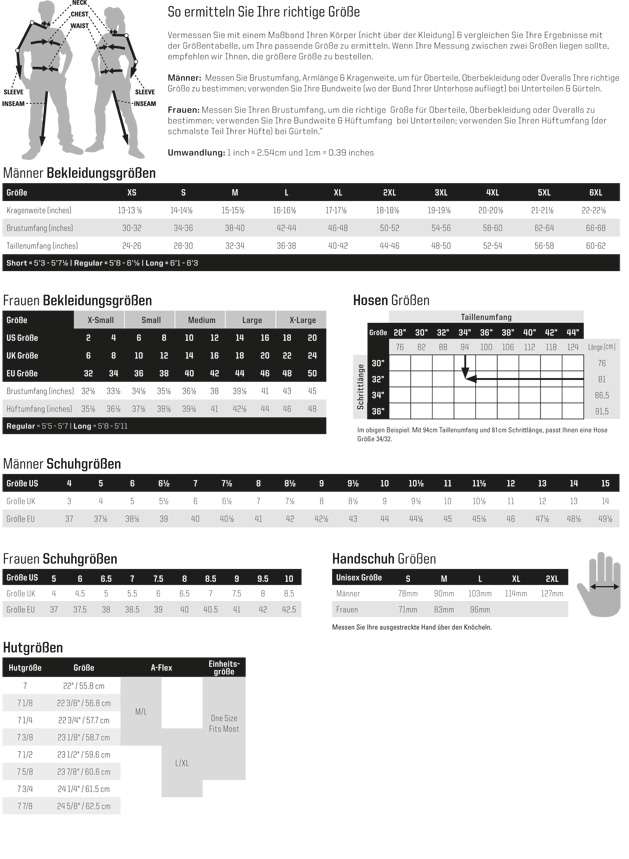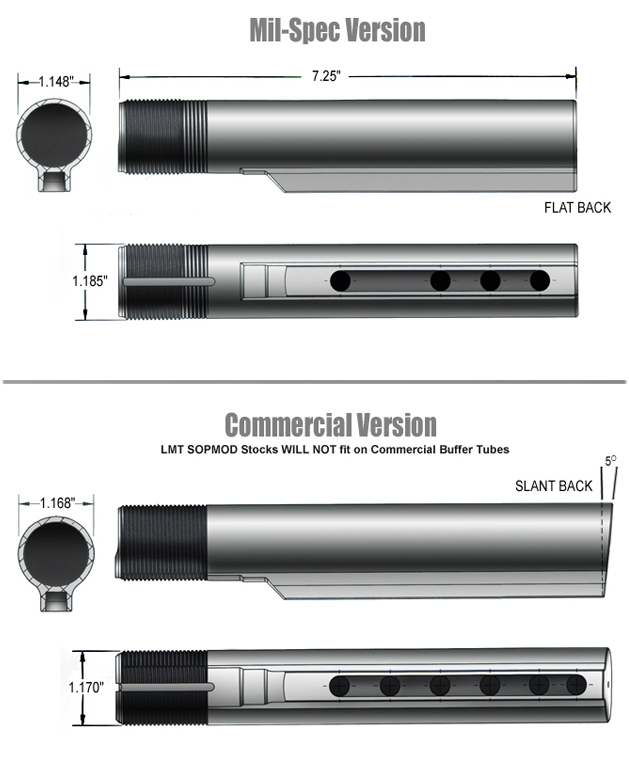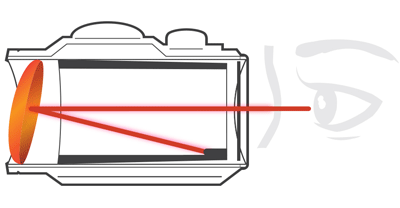Technik
5.11 Grössentabellen

First- & Second Focal Plane
FFP = First Focal Plane: Das Absehen ist in der ersten Bildebene womit dieses mitvergrössert wird, die Massangaben (subtensions) sind somit gleichbleibend, ungeachtet der gewählten Vergrösserung.
SFP = Second Focal Plane: Das Absehen ist in der zweiten Bildebene womit die Massangaben (subtensions) nur bei einer bestimmten Vergrösserung gelten (bei Vortex Produkten z.B. üblicherweise in der grössten Vergrösserung).
Mil-Spec versus Com-Spec AR15 Buffer Tube
Durchmesser Mil Spec: 1.148 Inch (= 2.916 cm)
Durchmesser Com Spec: 1.168 Inch (= 2.967 cm)
1 Inch = 2.54cm

NIJ Body Armor Classification Levels
Dieser Eintrag ist nur in englischer Sprache verfügbar.
Personal body armor covered by this standard is classified into five types (IIA, II, IIIA, III, IV) by level of ballistic performance. In addition, a special test class is defined to allow armor to be validated against threats that may not be covered by the five standard classes. The classification of an armor panel that provides two or more levels of NIJ ballistic protection at different locations on the ballistic panel shall be that of the minimum ballistic protection provided at any location on the panel.
2.1 Type IIA (9 mm; .40 S&W)
Type IIA armor that is new and unworn shall be tested with 9 mm Full Metal Jacketed Round Nose (FMJ RN) bullets with a specified mass of 8.0 g (124 gr) and a velocity of 373 m/s ± 9.1 m/s (1225 ft/s ± 30 ft/s) and with .40 S&W Full Metal Jacketed (FMJ) bullets with a specified mass of 11.7 g (180 gr) and a velocity of 352 m/s ± 9.1 m/s (1155 ft/s ± 30 ft/s). Type IIA armor that has been conditioned shall be tested with 9 mm FMJ RN bullets with a specified mass of 8.0 g (124 gr) and a velocity of 355 m/s ± 9.1 m/s (1165 ft/s ± 30 ft/s) and with .40 S&W FMJ bullets with a specified mass of 11.7 g (180 gr) and a velocity of 325 m/s ± 9.1 m/s (1065 ft/s ± 30 ft/s).
2.2 Type II (9 mm; .357 Magnum)
Type II armor that is new and unworn shall be tested with 9 mm FMJ RN bullets with a specified mass of 8.0 g (124 gr) and a velocity of 398 m/s ± 9.1 m/s (1305 ft/s ± 30 ft/s) and with .357 Magnum Jacketed Soft Point (JSP) bullets with a specified mass of 10.2 g (158 gr) and a velocity of 436 m/s ± 9.1 m/s (1430 ft/s ± 30 ft/s).
Type II armor that has been conditioned shall be tested with 9 mm FMJ RN bullets with a specified mass of 8.0 g (124 gr) and a velocity of 379 m/s ±9.1 m/s (1245 ft/s ± 30 ft/s) and with .357 Magnum JSP bullets with a specified mass of 10.2 g (158 gr) and a velocity of 408 m/s ±9.1 m/s (1340 ft/s ± 30 ft/s).
2.3 Type IIIA (.357 SIG; .44 Magnum)
Type IIIA armor that is new and unworn shall be tested with .357 SIG FMJ Flat Nose (FN) bullets with a specified mass of 8.1 g (125 gr) and a velocity of 448 m/s ± 9.1 m/s (1470 ft/s ± 30 ft/s) and with .44 Magnum Semi Jacketed Hollow Point (SJHP) bullets with a specified mass of 15.6 g (240 gr) and a velocity of 436 m/s ± 9.1 m/s (1430 ft/s ± 30 ft/s). Type IIIA armor that has been conditioned shall be tested with .357 SIG FMJ FN bullets with a specified mass of 8.1 g (125 gr) and a velocity of 430 m/s ± 9.1 m/s (1410 ft/s ± 30 ft/s) and with .44 Magnum SJHP bullets with a specified mass of 15.6 g (240 gr) and a velocity of 408 m/s ± 9.1 m/s (1340 ft/s ± 30 ft/s).
2.4 Type III (Rifles)
Type III hard armor or plate inserts shall be tested in a conditioned state with 7.62 mm FMJ, steel jacketed bullets (U.S. Military designation M80) with a specified mass of 9.6 g (147 gr) and a velocity of 847 m/s ± 9.1 m/s (2780 ft/s ± 30 ft/s).
Type III flexible armor shall be tested in both the “as new” state and the conditioned state with 7.62 mm FMJ, steel jacketed bullets (U.S. Military designation M80) with a specified mass of 9.6 g (147 gr) and a velocity of 847 m/s ± 9.1 m/s (2780 ft/s ± 30 ft/s).
For a Type III hard armor or plate insert that will be tested as an in conjunction design, the flexible armor shall be tested in accordance with this standard and found compliant as a stand-alone armor at its specified threat level. The combination of the flexible armor and hard armor/plate shall then be tested as a system and found to provide protection at the system’s specified threat level. NIJ-approved hard armors and plate inserts must be clearly labeled as providing ballistic protection only when worn in conjunction with the NIJ-approved flexible armor system with which they were tested.
2.5 Type IV (Armor Piercing Rifle)
Type IV hard armor or plate inserts shall be tested in a conditioned state with .30 caliber armor piercing (AP) bullets (U.S. Military designation M2 AP) with a specified mass of 10.8 g (166 gr) and a velocity of 878 m/s ± 9.1 m/s (2880 ft/s ± 30 ft/s).
Type IV flexible armor shall be tested in both the “as new” state and the conditioned state with .30 caliber AP bullets (U.S. Military designation M2 AP) with a specified mass of 10.8 g (166 gr) and a velocity of 878 m/s ± 9.1 m/s (2880 ft/s ± 30 ft/s).
For a Type IV hard armor or plate insert that will be tested as an in conjunction design, the flexible armor shall be tested in accordance with this standard and found compliant as a stand-alone armor at its specified threat level. The combination of the flexible armor and hard armor/plate shall then be tested as a system and found to provide protection at the system’s specified threat level. NIJ-approved hard armors and plate inserts must be clearly labeled as providing ballistic protection only when worn in conjunction with the NIJ-approved flexible armor system with which they were tested.
Was ist eine NSN?
Eine National Stock Number (NSN), wie sie in den USA heisst, oder auch bekannt als NATO Stock Number, ist ein 13-stelliger numerischer Code zur Identifizierung von standardisiertem Material welches von allen NATO-Staaten, einschliesslich dem US Department of Defense, anerkannt worden ist. Ein Artikel mit einer NSN gilt als „anerkannt“ was die Kaufabwicklung für Behörden vereinfacht.
Schutzstandards für Brillen & Schutzbrillen
ANSI Z87.1
Die amerikanische Richtlinie ANSI definiert die wesentlichen Anforderungen für Vorrichtungen zum Augen-und Gesichtsschutz, um z.B. Unfälle wie Stöße etc. zu minimieren bzw. vorzubeugen.
EN ISO 12312-1
Diese Norm entspricht der deutschen DIN-Norm und beschreibt u.a. die gesetzlichen Vorschriften / Mindestanforderungen für Sonnenbrillen für den allgemeinen Gebrauch sowie die Anforderungen an Schutzfilter für die direkte Beobachtung der Sonne.
EN 166
Der Augenschutz im Berufsalltag wird durch die Norm EN166 geregelt. Es handelt sich hierbei um die Kennzeichnung der europäischen Norm für den Augenschutz, welche den gesamten persönlichen Augenschutz klassifiziert und regelt.
MIL-PRF-31013
MIL-PRF-31013 ist ein US-Militär-Standard für offene Brillen und spezielle Schutzbrillen um dessen ballistische Wirksamkeit zu testen.
MIL-DTL-43511D
MIL-DTL-43511D ist ein US-Militär-Standard für geschlossene Brillen und spezielle Schutzbrillen um dessen ballistische Wirksamkeit zu testen.
STANAG 2920/4296
STANAG ist die Abkürzung für Standardisierungsübereinkommen, im Original „Standardization Agreement“. Das Übereinkommen befasst sich mit dem Prüfen der ballistischen Bedrohung durch Splitterdarstellungsgeschosse. In einem speziellen Prüfverfahren, V-50 genannt, muss die eine Hälfte der Schüsse den Zielwerkstoff durchdringen und die andere Hälfte der Schüsse darf den Zielwerkstoff nicht durchdringen. Für die Berechnung des V-50 Wertes wird eine gerade Anzahl von Schüssen, mindestens sechs, verwendet. Der gemessene Wert ist das arithmetische Mittel der Gruppe von gemessenen Geschwindigkeiten.
Warum ist die Frontlinse meiner Rotpunkt Zielhilfe schräg?
Red Dot Linsen Positionierung: Alle Red Dot Visiere haben eine Objektivlinse an der Vorderseite des Geräts, die eine sphärische Form aufweist. Im Gegensatz zu einem herkömmlichen Zielfernrohr ist jedoch die Objektivlinse in einem Rotpunktvisier schräg eingesetzt und scheint geneigt wenn man auf das Visier schaut. Dieser Winkel der Frontlinse ermöglicht, dass das von der batteriebetriebenen LED-Lichtquelle innerhalb des Geräts erzeugte Licht zurück in das Gerät reflektiert wird. Das reflektierte Licht wird zum "Punkt" oder zur Zielreferenz, die der Anwender sieht, wenn ein Rotpunktvisier eingeschaltet wird.

Dieses "Biegen" des Lichts macht die heutigen Rotpunktvisiere so beliebt und einfach zu bedienen. Auf der Innenseite des Visiers wird Klebstoff verwendet, um die LED an der Innenseite des Gehäuses zu befestigen. Design-bedingt ist die LED-Einheit im Sichtfeld leicht erkennbar.





